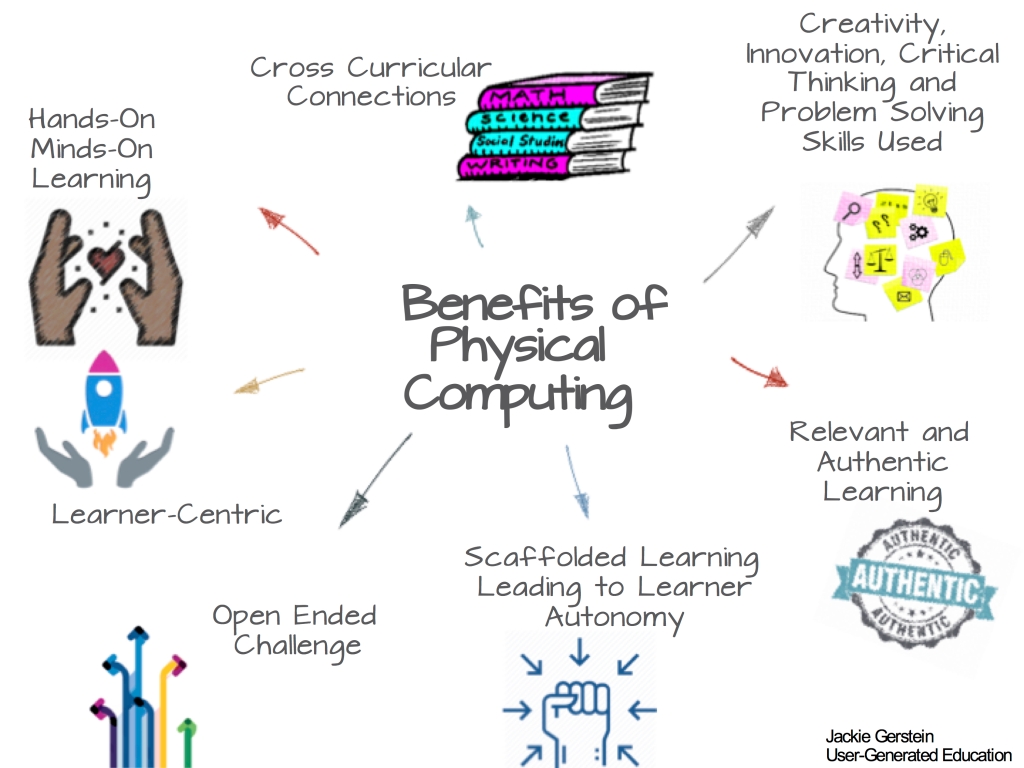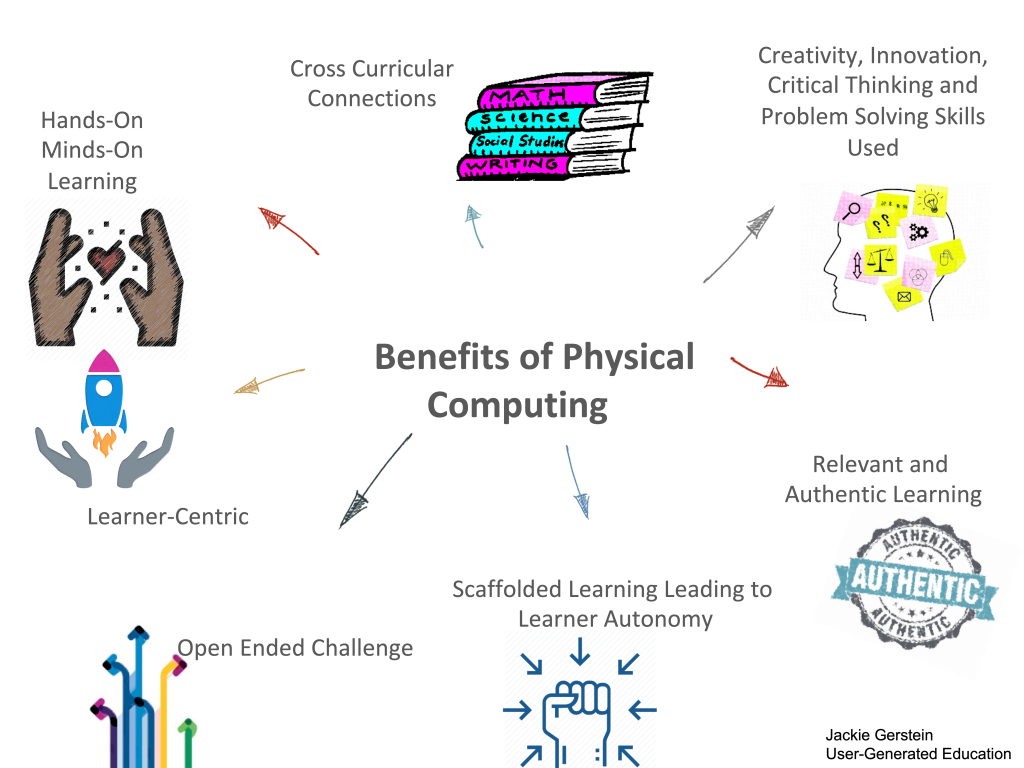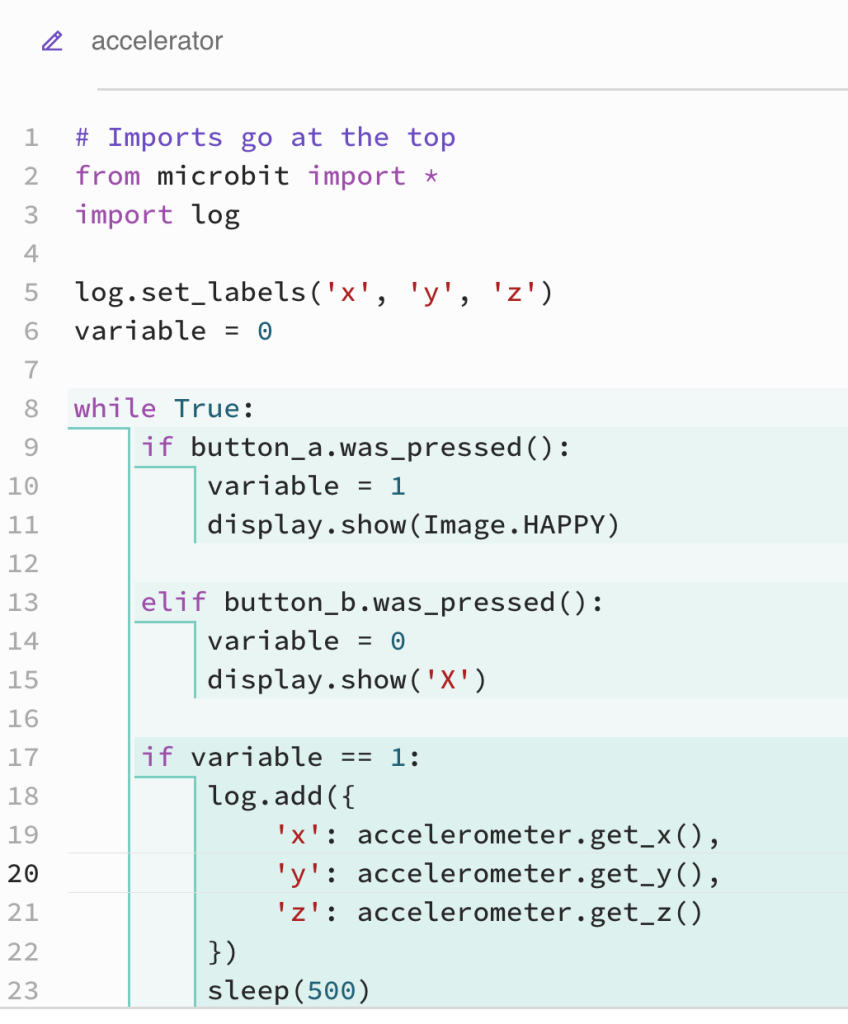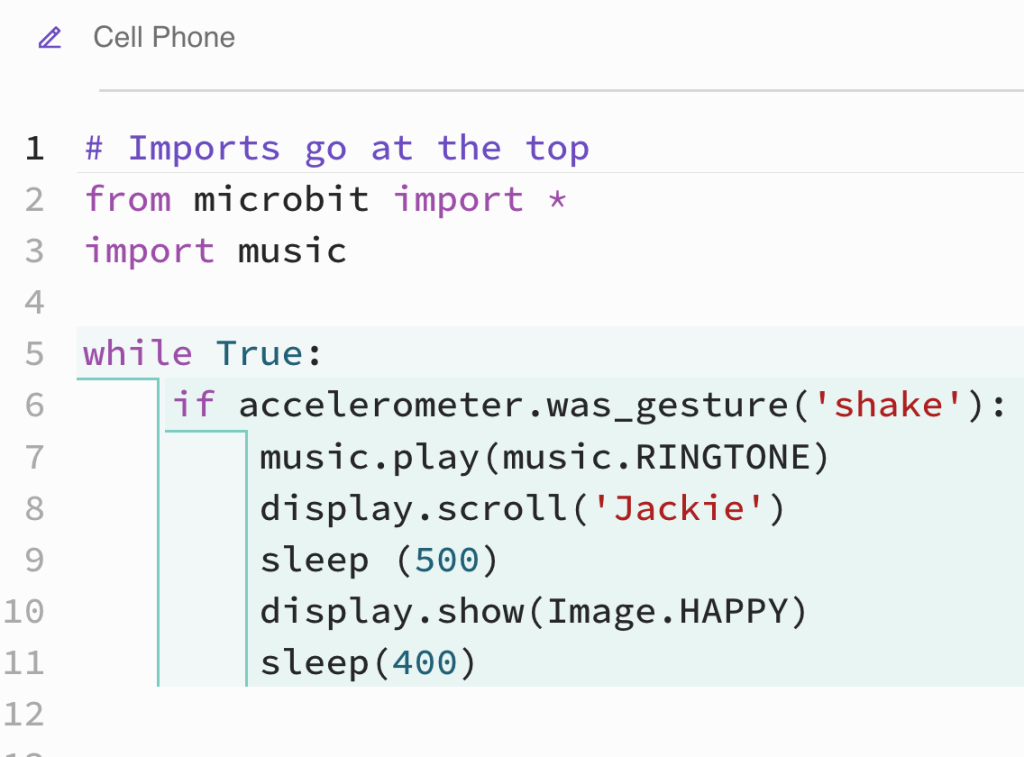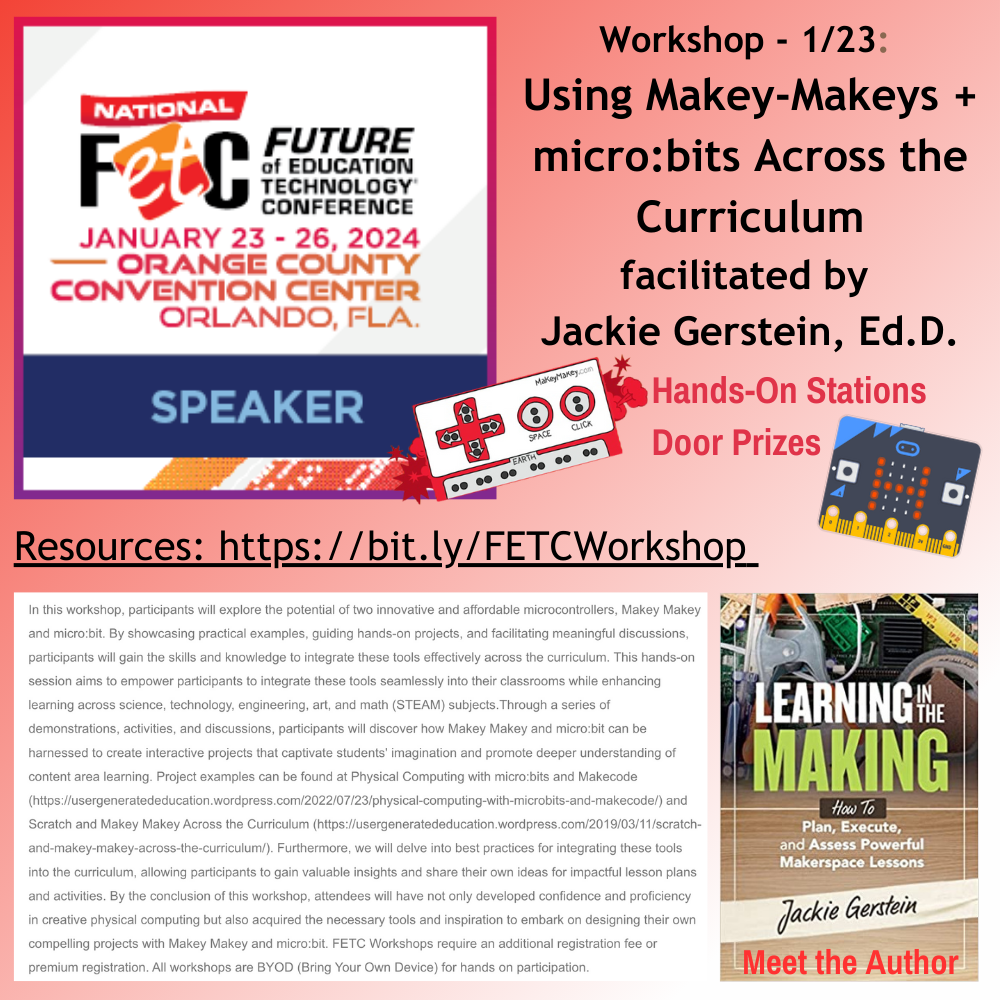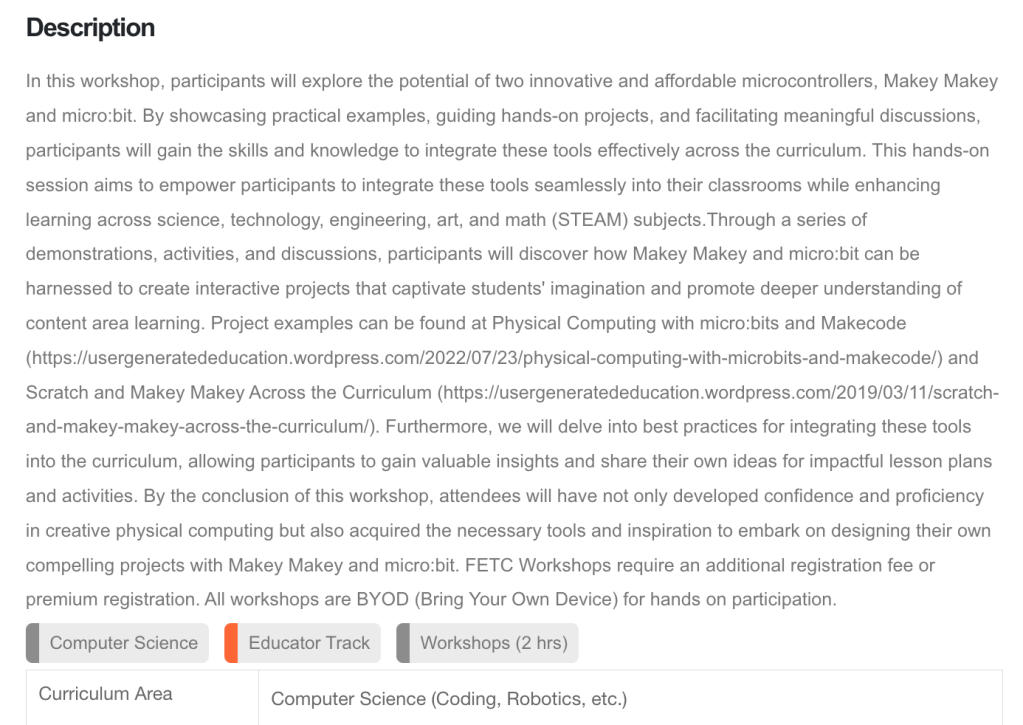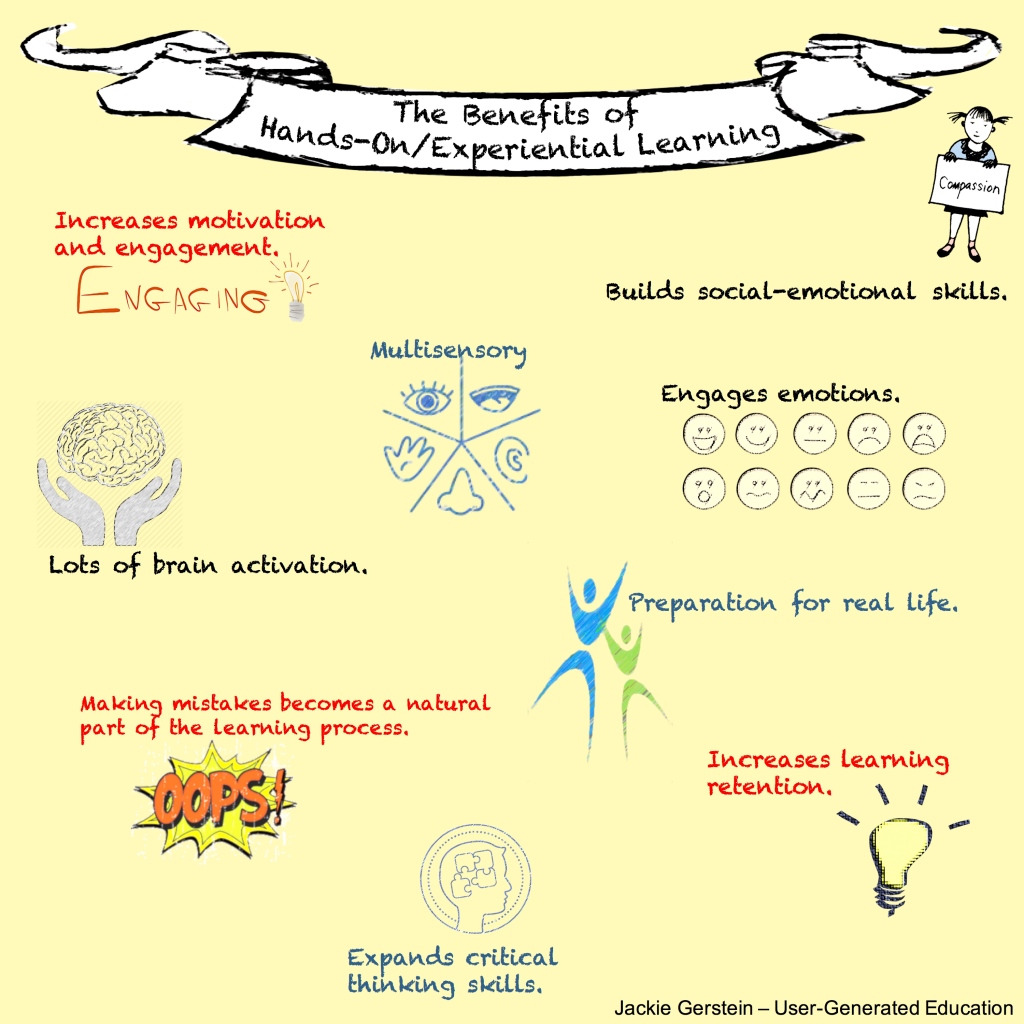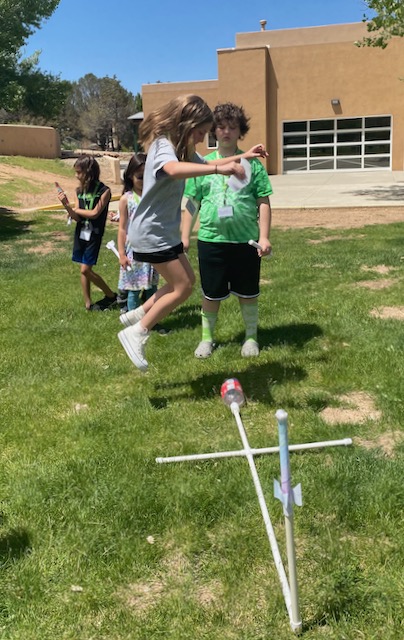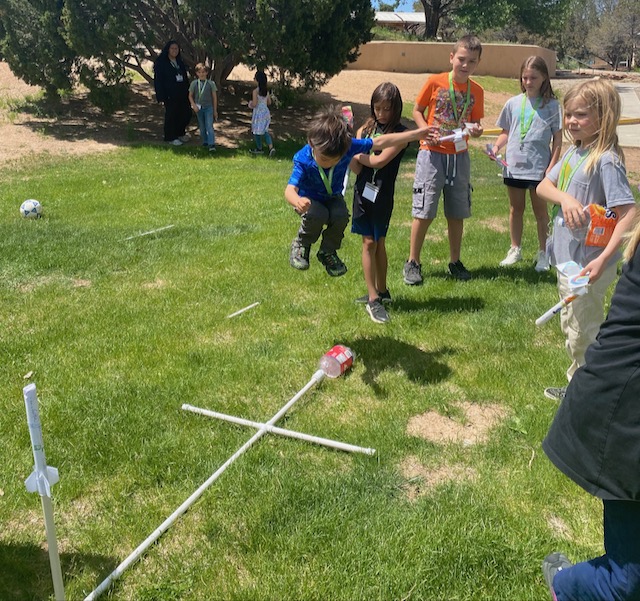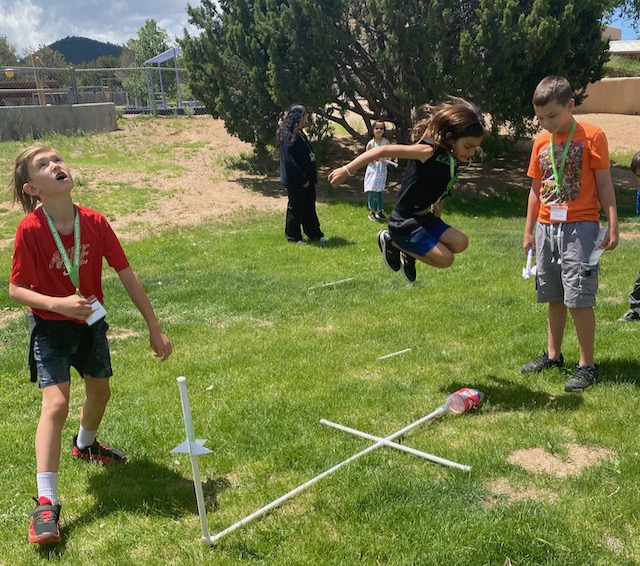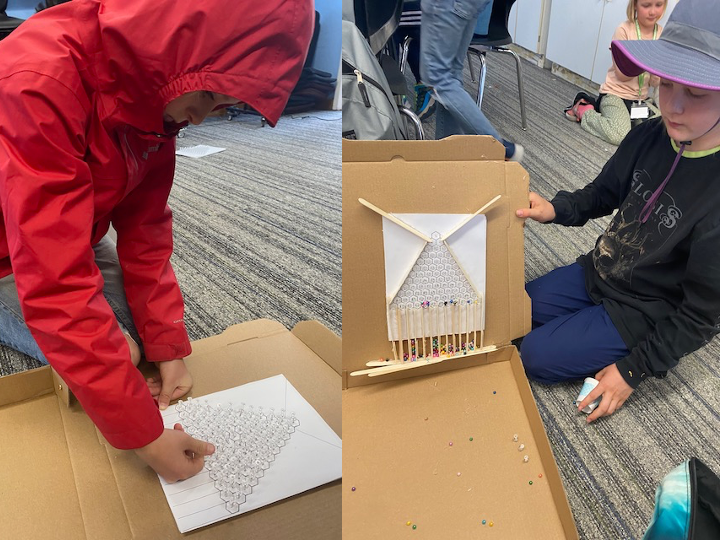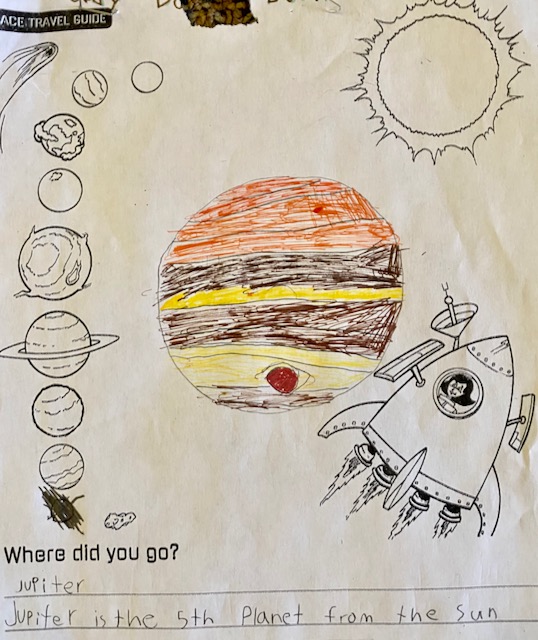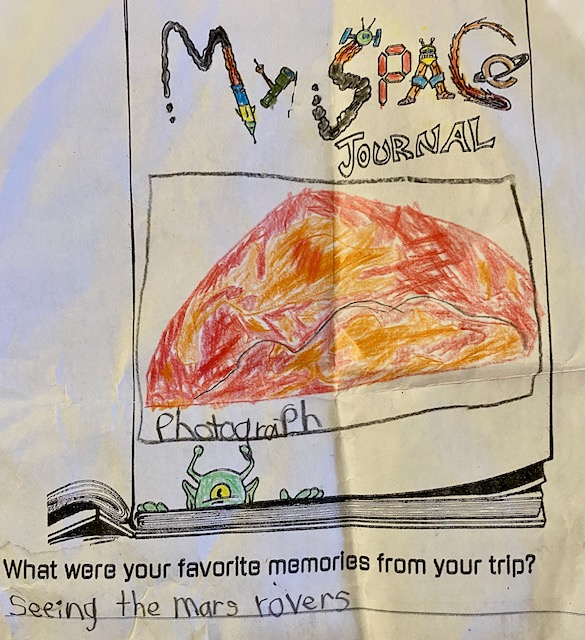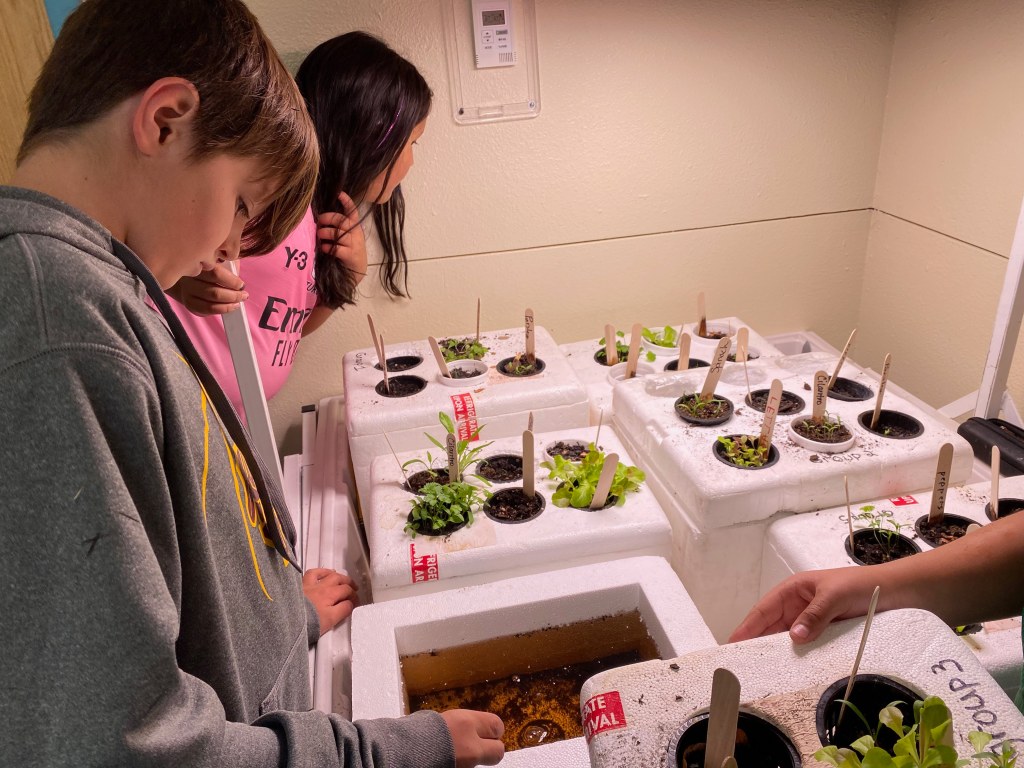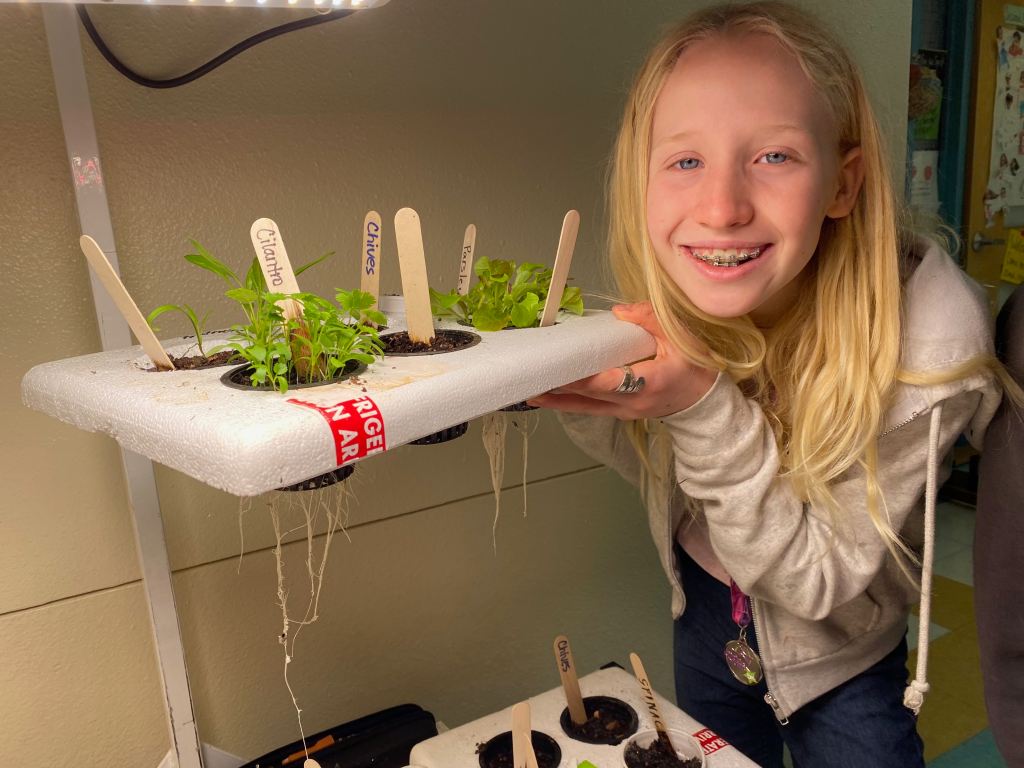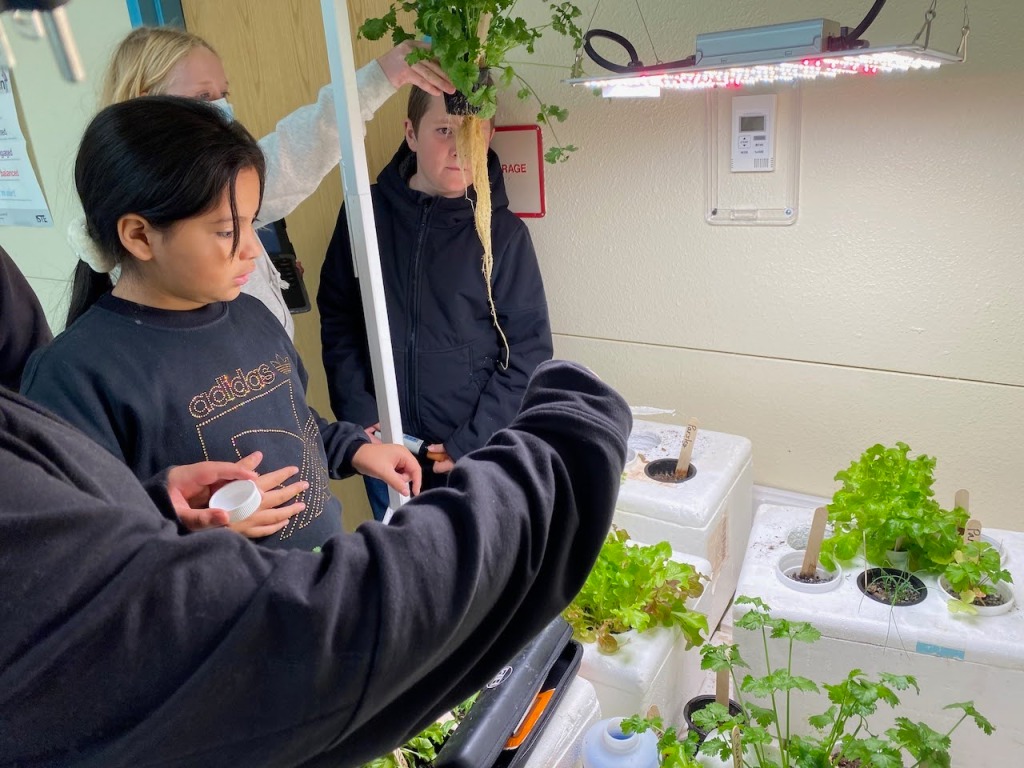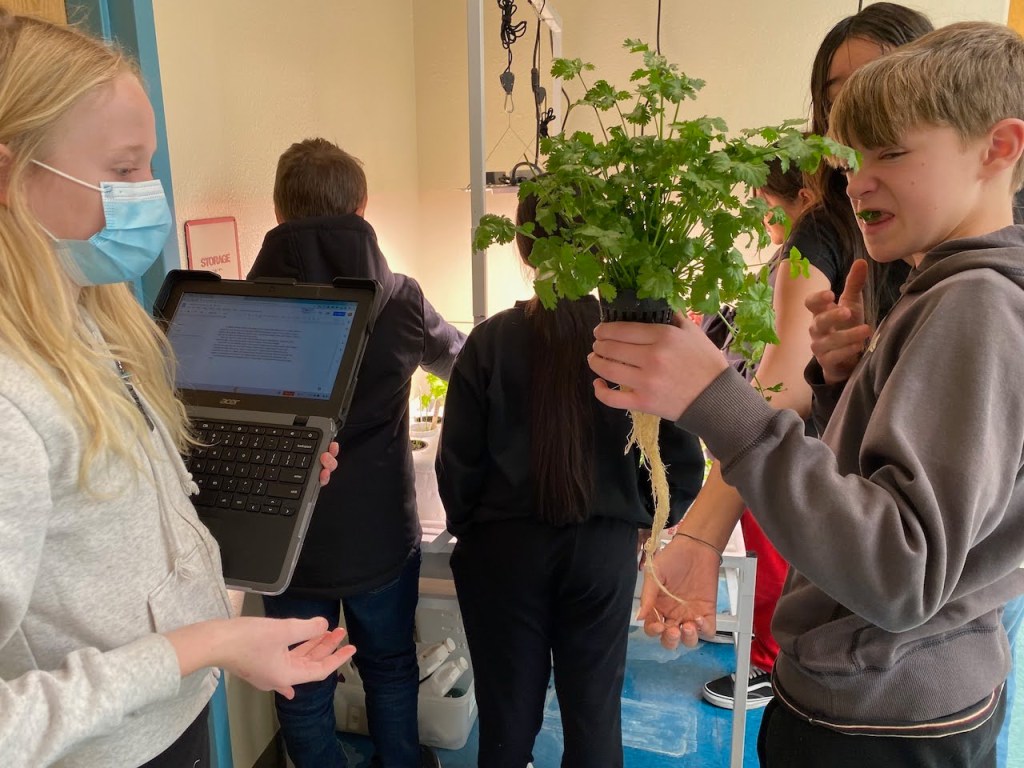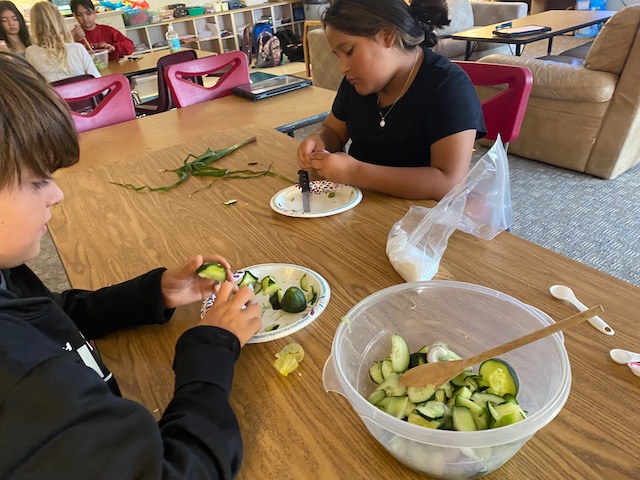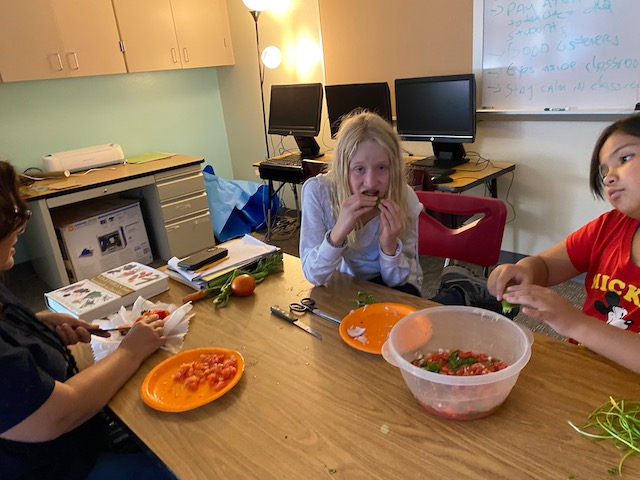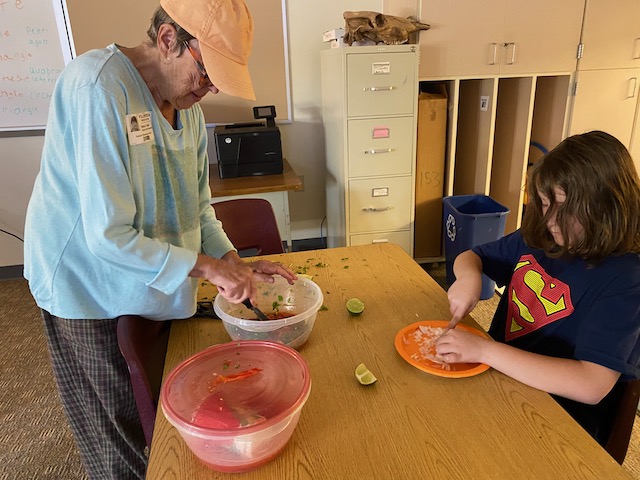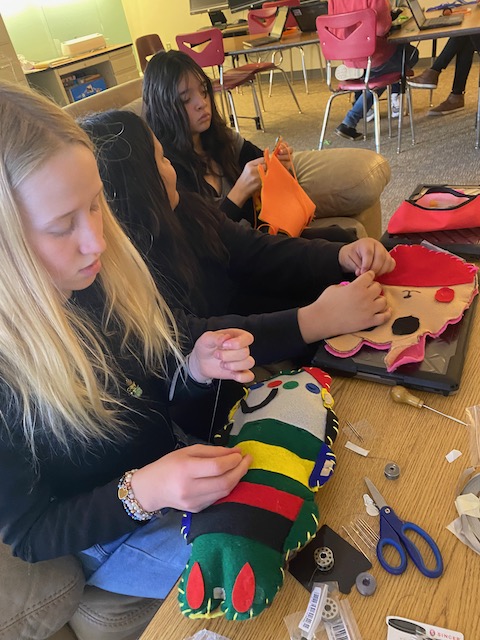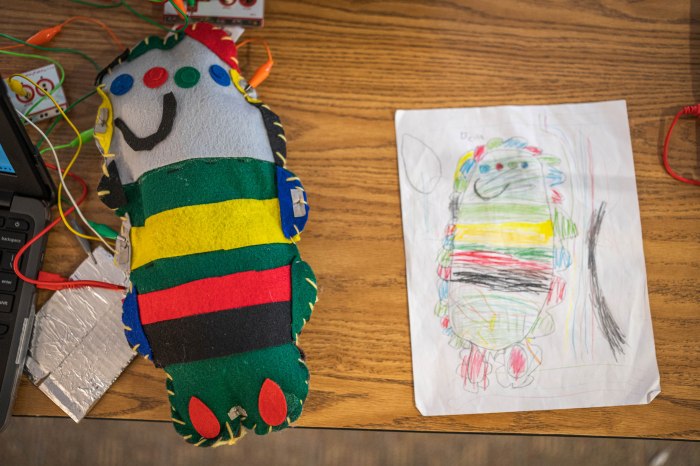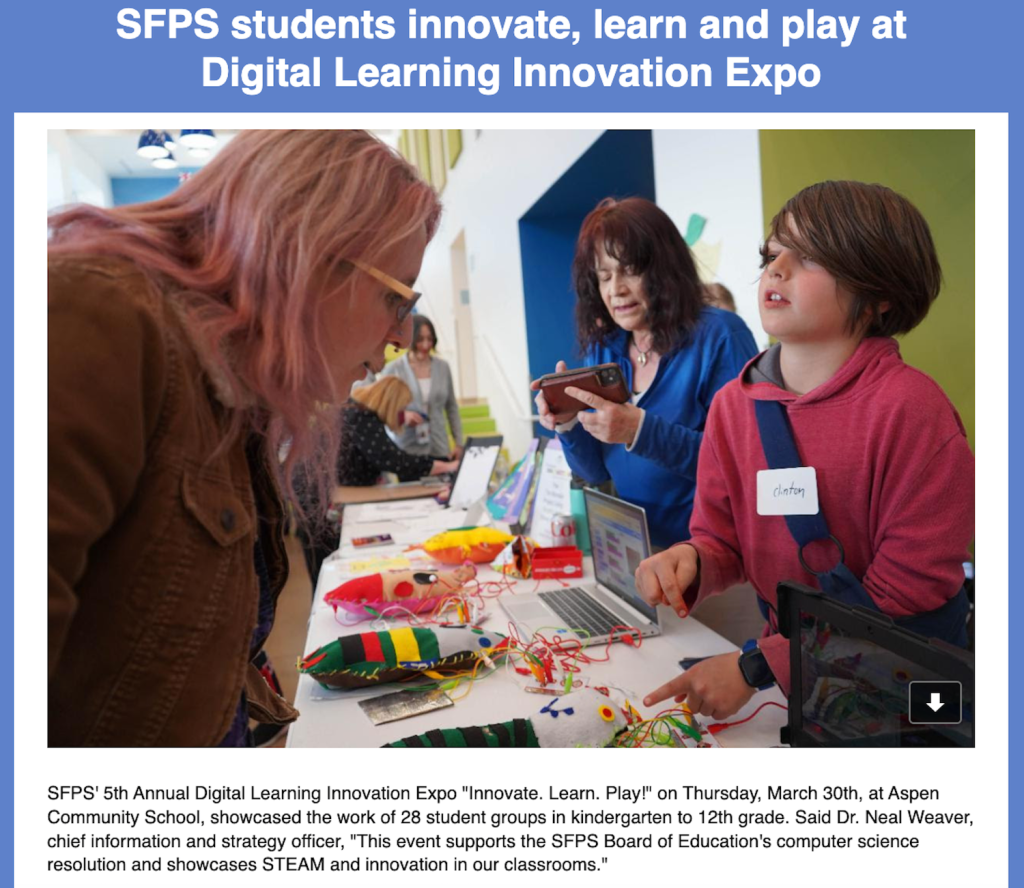Author Archive
micro:bit Projects Coded with Python
I have a strong emphasis with a few groups of my gifted students in integrating physical computing into my instructional activities. I’ve discussed the benefits of physical computing in Scratch and Makey Makey Across the Curriculum.
As I have my students in my classes for several years during their 2nd through 6th grade education, I start teaching them block coding using MakeCode and Scratch in the early grades. As such, this year, due to a desire to advance their skills, I’ve begun having the students use Python for the micro:bit to combine physical computing and learning Python.
Python is an excellent first text-based language to learn. Its instructions and syntax are based on natural language, making code easy to read, understand and modify. As well as being widely used in education, it’s used in industry, especially in the areas of data science and machine learning. Python is not just used by software developers, but also by people working in fields as diverse as medicine, physics and finance. Python on the BBC micro:bit brings the benefits of physical computing to students aged 11-14, learning programming fundamentals through text-based coding: immersive, creative experiences for students that help build engagement and knowledge (https://microbit.org/get-started/user-guide/python-editor/).
Standards Addressed
ISTE Standards for Students
- Know and use a deliberate design process for generating ideas, testing theories, creating innovative artifacts or solving authentic problems.
- Develop, test and refine prototypes as part of a cyclical design process.
- Exhibit a tolerance for ambiguity, perseverance and the capacity to work with open-ended problems.
- Create original works or responsibly repurpose or remix digital resources into new creations.
Next Generation Science Standards
- Analyze data from tests to determine similarities and differences among several design solutions to identify the best characteristics of each that can be combined into a new solution to better meet the criteria for success.
- Develop a model to generate data for iterative testing and modification of a proposed object, tool, or process such that an optimal design can be achieved.
Math Standards
- Measure angles in whole-number degrees using a protractor. Sketch angles of specified measure.
- Graph points on the coordinate plane to solve real-world and mathematical problems.
Here are some of the projects they’ve completed:
Spoon Race Using the micro:bit Python Data Logger
The Egg and Spoon race is a game where a player carries an object (like an egg) across some distance without it falling out of a holder. In the case of the Egg and Spoon, the player must carefully walk with an egg held in a spoon. The egg must remain in the spoon until the player crosses the finish line. The egg can easily roll out of the spoon so the player needs skill and patience to balance the egg until finishing the race (https://makecode.microbit.org/examples/egg-and-spoon).
The micro:bit can be programmed to record data about how much shake occurs during the race. The winner is the one with the least amount of shake. See more about it at https://microbit.org/projects/make-it-code-it/python-wireless-data-logger/.
Thanks, Katie Henry and Jacqueline Russell, for this!
The code – https://drive.google.com/file/d/1gsc1ghanyL7CvXV6HQXnzJRcLVkFN3NU/view?usp=sharing.
FYI – the students absolutely loved this!
micro:bit Pal Coded with Python
The micro:bit is coded to make a pal. It is customized with different images and the built-in speaker to make it even more fun with its expressive sounds (music, expressive sounds, and speech).
The code – https://drive.google.com/file/d/1p8RIGQIGTLloAqXwjswdxlNFvkjDuF3_/view?usp=sharing.
micro:bit Warmer-Colder Game
In this old children’s game, one player hides an object hides an object that other player seeks to find. Temperature words tell them if they are moving towards the object (getting warmer) or away from it (getting colder). In this case, the micro:bit radio function is used by the hider to give hints through the micro:bit to the seeker.
The code – https://drive.google.com/file/d/1-F8D9wx81r8ESqhi_KUA5zCy3L_8oPsQ/view?usp=sharing
Advanced micro:bit Projects: Artificial Intelligence/Teachable Machine, the Data Logger Spoon Race, and micro:bit Pal Coded with Python
I love bringing physical computing into my classrooms:
Physical computing refers to the use of tangible, embedded microcontroller-based interactive systems that can sense the world around them and/or control outputs such as lights, displays and motors. Assembling the hardware elements of a physical computer and programming it with the desired behavior provides a creative and educational experience. A variety of physical computing devices are established in the market, including: Arduino, Raspberry Pi, Circuit Playground, and the BBC micro:bit (https://www.microsoft.com/en-us/research/project/physical-computing/)
. . . but as with all use of educational technologies, I believe that it should be used intentionally to assist learners in developing and expanding their content knowledge and life skills.
Standards Addressed
ISTE Standards for Students
- Know and use a deliberate design process for generating ideas, testing theories, creating innovative artifacts or solving authentic problems.
- Develop, test and refine prototypes as part of a cyclical design process.
- Exhibit a tolerance for ambiguity, perseverance and the capacity to work with open-ended problems.
- Create original works or responsibly repurpose or remix digital resources into new creations.
Next Generation Science Standards
- Analyze data from tests to determine similarities and differences among several design solutions to identify the best characteristics of each that can be combined into a new solution to better meet the criteria for success.
- Develop a model to generate data for iterative testing and modification of a proposed object, tool, or process such that an optimal design can be achieved.
Math Standards
- Measure angles in whole-number degrees using a protractor. Sketch angles of specified measure.
- Graph points on the coordinate plane to solve real-world and mathematical problems.
Artificial Intelligence, the Teachable Machine, and micro:bits
Thanks, Cora Yang, for this!
The Data Logger Spoon Race with micro:bits and MakeCode
Thanks, Katie Henry and Jacqueline Russell, for this!
The micro:bit Python editor can also be used to code the data logger for the spoon race:
micro:bit Pal Coded with Python
Python is an excellent first text-based language to learn. Its instructions and syntax are based on natural language, making code easy to read, understand and modify. As well as being widely used in education, it’s used in industry, especially in the areas of data science and machine learning. Python is not just used by software developers, but also by people working in fields as diverse as medicine, physics and finance. Python on the BBC micro:bit brings the benefits of physical computing to students aged 11-14, learning programming fundamentals through text-based coding: immersive, creative experiences for students that help build engagement and knowledge (https://microbit.org/get-started/user-guide/python-editor/).
Here is a micro:bit pal coded with Python example that I will share with my students:
. . . and the code is:
Here are some student micro:bit pals coded with Python:
Workshop: Using Makey Makeys and micro:bits Across the Curriculum
This is an overview of my workshop at FETC (Future of Technology Education Conference).
Description from the Conference Program
Workshop Slides
Wakelet of Workshop Resources
Applications of Artificial Intelligence Tools in the Gifted Education Classroom – A Conference Presentation
I had the opportunity to present AI Tools in the Gifted Education Classroom at the UCONN national gifted conference, Confratute 2023 (and more recently in person at the New Mexico Association for the Gifted conference). My session description (originally written by me and tweaked by ChatGPT) was:
Incorporating AI tools into the gifted education classroom can offer new and exciting opportunities for both teachers and students. By embracing these tools and learning how to use them effectively, we can prepare our students for the future and stay ahead of the curve. This hands-on session provides examples of how AI can be used in the classroom. Machine learning activities, creation of chatbots, AI art and stories, and a pledge for using AI will be demonstrated. Participants have time to explore and develop AI-driven activities for their own work settings.
Slide Deck
Here are my slides and activities (note: it was geared for gifted education but there are lots of AI tools and activities for a general school population):
Agenda
The agenda for this hour long session was:
- Warm Ups/Sampler
- Music + Voice Generated AI Intro
- Would You Rather (generated by Auto Classmate)
- Adobe Express – Animate 2 Truth
- AI for Gifted Students
- Slides generated by AI – gamma.ai
- Information: Canva, ChatGPT, Character,ai, Codebreaker’s chat
- Interactive by Curipod
- Student Activities
- Code.org AI Activities
- Machine Learning – Rock Papers Scissors
- DIY Chatbots (using Scratch 3.0)
- Using ChatGPT Student Pledge
- Story Writing by ChatGPT/Dall.e
- Teacher Production Tools
- Prompt Development
- Lesson Assisters – Curipod, Magic School, Auto Classmate, Codebreaker Chat
- Issues
- AI – Background Information
Video Highlights of Live Presentation
Reflection
- Overall, it seemed to go well. I chose to start with simple AI activities that required very limited technology and AI background knowledge since I believed this would fit the demographic of conference attendees.
- I began with a “Would You Rather” activity from Auto Classmate with the prompt of using AI in the classroom, humorous version. My gifted students love “Would You Rather” activities and I was thrilled when I found this on Auto Classmate – https://autoclassmate.io/tools/would-you-rather-question-generator/. It generates questions on any topic for any grade. I think the session participants enjoyed it. I did 6 out of the 10 questions, but given that the session was only an hour long, I would have only done a few.
- Next I demonstrated Adobe Express Animate – https://express.adobe.com/express-apps/animate-from-audio/?isEdu= animating my avatar to play my two truths and a lie game. I then asked the session participants to make their own. This is a very quick tool, and believe it was worth the time to have the participants make their own. I had a few participants share the ones they made. Again, due to my limited time, I would have had only one participant share.
- Next, I gave them a 3 minute block to explore information about the benefits of using AI with gifted students through AI generated content creation tools, Gamma.ai, ChatGPT, Canva’s Magic Write, Character.ai, Codebreakers’ chat,
- This was followed by an interactive slide show via Curipod (think Peardeck or Nearpod). I had good engagement but would have liked to have spent more time on it.
- Because of the limited time (and I knew this would happen), I gave them a choice between seeing the student activities or playing with the teacher production tools. I was happy they selected the student activities. I had done and documented several AI activities (Teaching Machine, Language Translators, Chatbots, Art Creation, Pledge for Using AI at School) with my students as I had begun teaching them about AI during Spring, 2022.
- I really love AI, was thrilled to do a PD session on it, and hope to get future opportunities to do it again.
The Beartown Play: A Play Written, Enhanced, and Performed by 6th Graders
I often give my students choice and voice which I discussed in my blog post, Giving Students Choice and Voice.
This project, written, enhance, and performed by 6th graders, was truly an example of voice and choice along with having them do a Type III enrichment project. Three 6th grade girls began this project last year in their gifted class as a stop-motion animation. They asked if they could continue it as a play when I become their gifted education teacher. I said, “Absolutely,” and provided some guidance and coaching as they worked on it all semester (about 3 hours per week).
This project could be classified as Type III enrichment as described in The Enrichment Triad Model developed by Joseph Renzulli, a leader and pioneer in gifted education. Type III Enrichment incorporates investigative activities and the development of creative products in which students assume roles as firsthand investigators, writers, artists, or other types of practicing professionals (https://renzullilearning.com/wp-content/uploads/2019/08/TheEnrichmentTriadModel.pdf).
For this project the girls:
- Wrote, refined, and formatted their script so it included dialogue that it sounded good and was grammatically correct, was formatted like a TV or movie script, had stage directions and good narrations.
- Created a broadway show type program designed in Canva.
- Included sound effects from the internet and uploaded into Google Slides in a way that made sense to their sound technician
- Included commercials written and recorded to be satires of local commercials.
- Made technology-enhanced costumes using fairy lights, Turtlestitch embroidered/LED lit patches, micro-bit/neopixels, and circuit playgrounds.
They elicited the assistance of 6th grade friends for the performance at our school’s talent show.
The Script
As stated above, the story was conceptualized and began the previous. The girls asked to continue it as a movie during this school year. We spent months revising it. I acted as a coach, pointing out plot holes and grammatical errors along with assisting them in formatting it in a standard script form.
Inserting Sound Effects
Recording Self-Composed Commercials
Making Costumes
The girls made patches for their story characters designing them in Turtlestitch, a browser-based educational programming language (Snap!) to generate patterns for embroidery machines, and then sewing them with an embroidery machine.


One student decided to light up her character’s patch using Lilypad lights. This was her first time sewing so she was rightfully proud of herself.
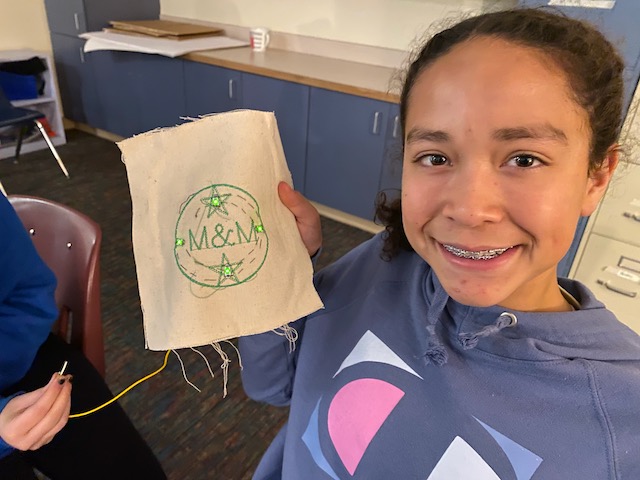

The girls used fairy lights to create head decorations and they coded Neopixels and Circuit Playgrounds to light up the other actors’ costumes.


Creating the Playbill Program
The girls examined Broadway Playbills and then used Canva to create their own.
The Performance
The video below contains some of the excerpts from the talent show performance (note that the girls only had a few rehearsals with their classmates and none in the gym using the mics that were used during the talent show.
Standards Addressed
Common Core State Standards – ELA
- Write narratives to develop real or imagined experiences or events using effective technique, relevant descriptive details, and well-structured event sequences.
- Engage and orient the reader by establishing a context and introducing a narrator and/or characters; organize an event sequence that unfolds naturally and logically.
- Use narrative techniques, such as dialogue, pacing, and description, to develop experiences, events, and/or characters.
ISTE Standards for Students
- Students leverage technology to take an active role in choosing, achieving and demonstrating competency in their learning goals, informed by the learning sciences.
- Students communicate clearly and express themselves creatively for a variety of purposes using the platforms, tools, styles, formats and digital media appropriate to their goals
NAGC Standards
- Students with gifts and talents demonstrate their potential or level of achievement in their domain(s) of talent and/or areas of interest.
- Students with gifts and talents demonstrate growth in personal competence and dispositions for exceptional academic and creative productivity. These include self-awareness, self-advocacy, self-efficacy, confidence, motivation, resilience, independence, curiosity, and risk taking.
- Students with gifts and talents develop competence in interpersonal and technical communication skills. They demonstrate advanced oral and written skills and creative expression. They display fluency with technologies that support effective communication and are competent consumers of media and technology.
Space Explorations, Science Fiction Writing, Shadow Puppet Shows: An Interdisciplinary Unit
I’ve discussed offering electives to my gifted elementary students. My group of 2nd/3rd graders chose space. It began as one would expect any study of space would begin – watching videos, visiting NASA websites, even playing some online games. They then selected planets to learn and research about. They learned basic researching skills and created a guide to their planets. This evolved into them working in pairs or trios to combine their planets to create new planets, aliens who inhabit their planet, and stories about them. In process now, they are creating shadow puppets in Tinkercad, cutting them on my Cricut machine, and fine tuning their scripts for the shadow puppet shows they performed for younger grades.
Standards Addressed
Next Generation Science Standards
- ETS1.C: Optimizing The Design Solution – Different solutions need to be tested in order to determine which of them best solves the problem, given the criteria and the constraints.
- ETS1.B: Developing Possible Solutions
Science and Engineering Practices
- Asking questions and defining problems
- Developing and using models
- Constructing explanations and designing solutions
- Obtaining, evaluating, and communicating information
ELA Anchor Standards
- Write informative/explanatory texts to examine and convey complex ideas and information clearly and accurately through the effective selection, organization, and analysis of content. (Writing Anchor 2)
- Conduct short as well as more sustained research projects based on focused questions, demonstrating understanding of the subject under investigation. (Writing Anchor 7)
- Present information, findings, and supporting evidence such that listeners can follow the line of reasoning…(Speaking/ Listening Anchor 4)
- Make strategic use of visual displays to express information and enhance understanding of presentations. (Speaking/ listening Anchor 5)
- Integrate and evaluate content presented in diverse media and formats, including visually and quantitatively, as well as in words. (Reading Anchor 7) (source: https://www.artsintegration.net/shadow-puppets.html)
NAGC (Gifted) Standards
- Creativity: The students are given the freedom to choose their own planets to research and create their own stories about them. They are also encouraged to use their imaginations to come up with new ideas for their shadow puppets.
- Problem-solving: The students are challenged to solve problems as they work together to create their new planets and shadow puppets. For example, they need to figure out how to combine their planets in a way that makes sense and how to create shadow puppets that are both creative and accurate.
- Critical thinking: The students are asked to think critically about the information they find as they research their planets. They need to evaluate the sources of their information and decide which ones are credible. They also need to think critically about the stories they create and make sure that they are consistent with the scientific facts they have learned.
- Communication: The students are given the opportunity to communicate their ideas in a variety of ways. They write reports about their planets, create presentations, and perform shadow puppet shows. This helps them to develop their communication skills and to share their knowledge with others.
Planet Exploration
Size and Distance of Planets
We began our unit by exploring through planets by size and How Big is the Solar System?.
Researching Planets
Based on initial explorations, students selected a planet to research. It started with Wikipedia and gave me the opportunity to teach them them how to:
- Skim an article using headings
- Copy and paste key passages into a Google doc
- Cite their sources by pasting in the link where they found the information
- Highlight key words

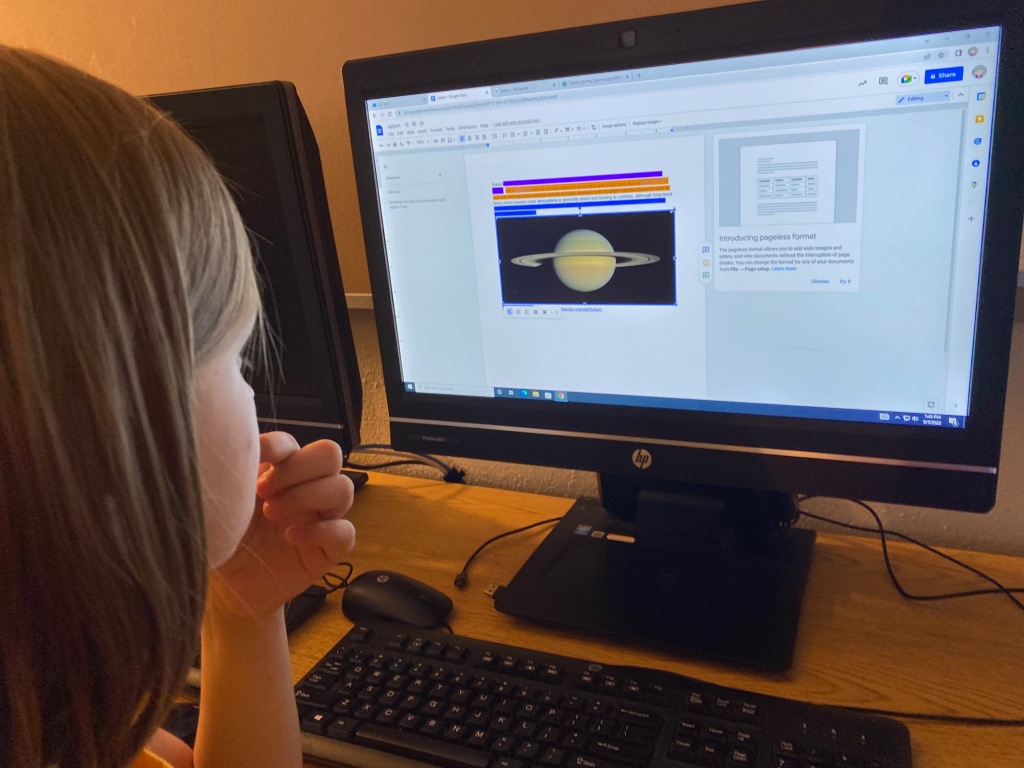
They explored more facts about their chosen planets through https://www.dkfindout.com/us/space/solar-system/ and https://www.planetsforkids.org/ adding more facts to their Google doc guides
Diving Deeper: Space Travel Guide
Students then completed Space Travel Guides for their their selected planets. These templates were found at https://www.amnh.org/explore/ology/astronomy/space-travel-guide2 (Spanish versions are available).
Some sample completed pages:
Creating New Planets
To move into story creation, students formed groups of two or three. Their first task was to combine what they learned about their original, real planets to create new fictional planets. Here is are some student examples:
One day all the planets where going around the solar system but then Jupiter and Mercury got mashed up! . Our planet’s name is Merpirter. Merpiter has 40 moons. Merpiter is the coldest planet in the Solar system about -35,500 C. degrees. The diameter of merpiter is 44,956 miles. Merpiter colors is like a brownish orange. The goddess of Merpiter is Jupas. Merpiter has big mountains.
How Vars Was Made: A star exploded In the solar system and Venus and Mars got smashed together to make Vars. How Vars got its moons: one of mars’s moons went around Vars while the other moon flew away. Terrain: the surface is half red half orange and vars has 10 volcanos.
Estimating Dimensions of New Planets
Several students included numerical facts about their planets. This gave me the opportunity to teach them about calculated averages.
Possible Vegetation and Creatures via Math Snacks’ Agrinautica
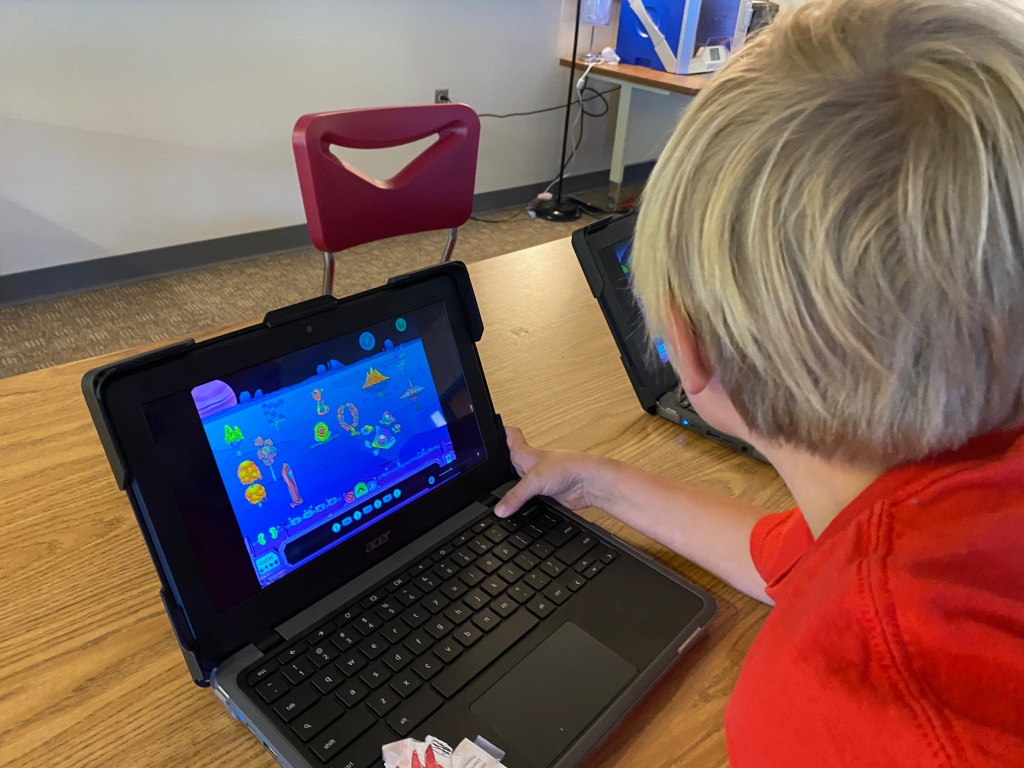

The app, Agrinautica, allows students to terraform planets by adding gorgeous plants, animals, fungi and minerals, each representing a unique mathematical expression. It s designed for 4th and 5th graders learning mathematical expression-building and order of operations, important pre-algebra skills.
I was so excited to discover this online math game. It fit perfectly into this unit and helped teach the gifted 2nd and 3rd graders some advanced math concepts.
Here is one group’s setting for their story created through this game.
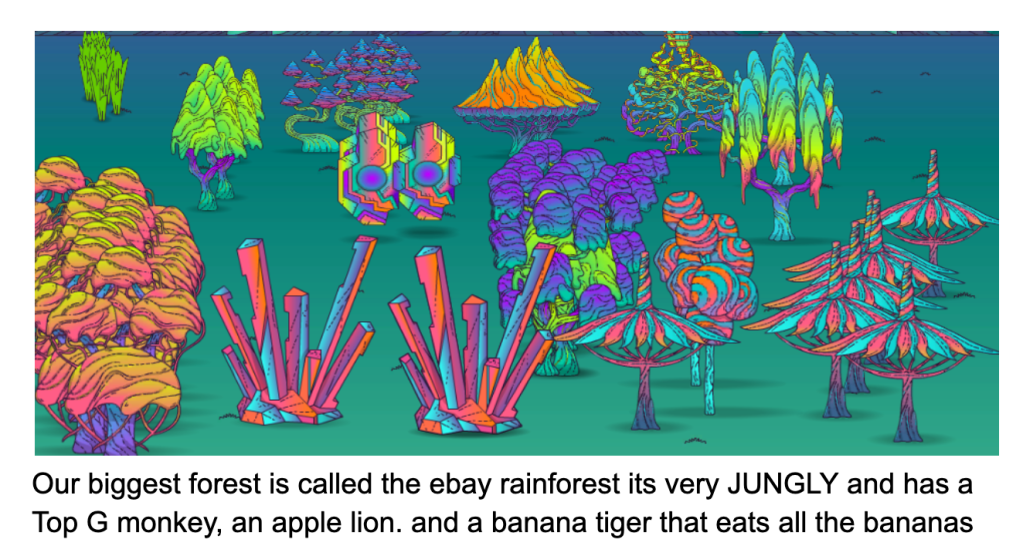
Writing Collaborative Stories
In their small groups, students wrote their stories by using the collaborative function of Storyboard That and Google docs. To begin, though, I shared a kid=friendly video (students ended up loving this) about a story arc.
Storyboard That
Storyboard That is an online storyboarding tool that makes it easy to create a digital story using both images, text, and storyboard templates. It offers a template for a story arc so it was perfect for my students. This is an example of one group’s creation.
Shadow Puppet Shows
The history and characteristics of shadow puppet shows were reviewed with the students.
Source: https://www.artsintegration.net/shadow-puppets.html
Writing Scripts
Since shadow puppet shows are often dialogue driven, lots of time was spent on creating dialogue for the different story arc events from the stories they already worked on. I realized they had some idea of the story arc, but needed some direct instruction. As such, for each event, the video above was reviewed, time was spent on writing the dialogue of that story arc event,
Creating Their Characters
They used Tinkercad to create the characters their shadow puppet shows.
I then cut their characters out using a Cricut Machine.
They then added wooden rods to the back in order to be able to move their puppets around the screen.

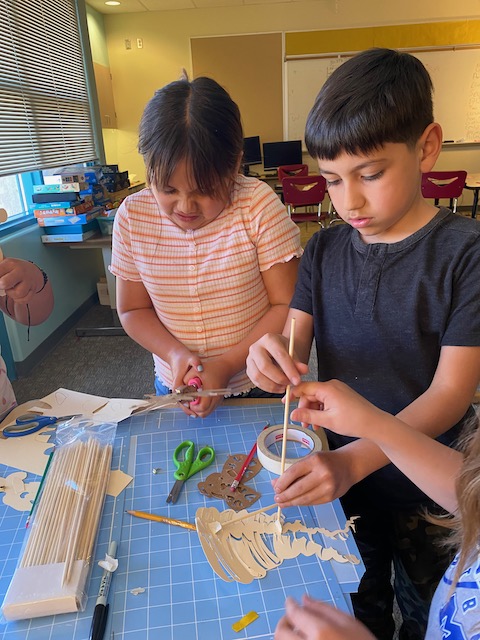
Making the Shadow Puppet Theater Screen
Directions for making the screen using a trifold (which I plan to do) can be found at http://www.pasttimeshistory.com/using-a-tri-fold-presentation-board-for-a-durable-screen/
(Note: These images are how I started teaching them about shadow puppet shows – through cutting out alien shadow puppets, showing them how to attach the rods and how to use them behind the screen.)
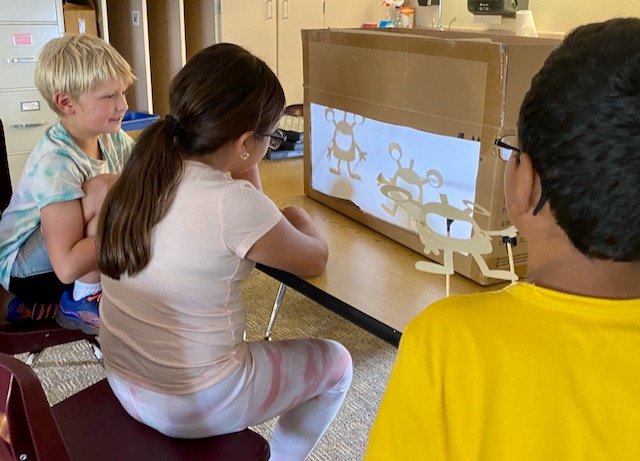

Shadow Puppet Show Performances
Students performed their shadow puppet shows for the younger grades. To introduce the puppet shows, students shared a little bit about their planets.
Gardening Program with SAGE Elementary Students
Our Title 1 school is lucky enough to have a decent size outdoor garden that is overseen by community volunteers. One of their goals is to teach our students about the garden.
Because of the that, I offered gardening as a possible elective for my GT (gifted and talented students). See Offering Electives to Elementary Students for more about why and how I offer electives to them. They joyfully selected gardening as one of them.
I also have the privilege of teaching my students multiple years. Along with a brief explanation of the activities for this elective, below is a video about the plants from the outdoor garden that the students created last school year, and one they created this year about our indoor hydroponic garden. (Note: Students are still in the process of composing the individual descriptions of the garden activities they did.)
Description of the Activities
We’ve been shaping our garden, and that comes with a lot of activities during spring and fall. These activities are all very fun. They included: garden class, plant anatomy and good eats. The garden class was very fun. It was basically reading out plant facts from a book. Plant anatomy was where they told us about the plant’s names and different parts.
Outdoor Garden
Our Salazar Green Garden has many diverse types of plants including peppers, tomatoes, rhubarb, mint, two different kinds of plum, peaches, and more! We donate to the Adelante food bank program, a way that Salazar can give back to the community.
Hydronic Garden
Students started a hydroponic garden and successfully grew lettuce, cilantro, spinach, and chives.
Healthy Eating
One of the goals of this program was to teach and have the students enjoy healthy foods.
Connecting School Standards to Gardening Resources
A school garden (however large or small) provides a meaningful context in which students can apply new academic concepts and skills. Whether they are graphing the temperature of their compost pile over time; reading a recipe to make fresh salsa; writing a story from the perspective of an ant; or presenting to a buddy class on the animals that visited their sunflower patch, the opportunities for children to practice traditional academic subjects in the garden are limitless! (Common Core and Next Generation Science in the Garden)
- Standards-Based Learning in a Garden https://www.edutopia.org/practice/garden-based-learning-engaging-students-their-environment
- Connecting the school garden to curriculum standards https://www.canr.msu.edu/news/connecting-the-school-garden-to-curriculum-standards
- From Seed to Plant https://www.monroe.edu/cms/lib/NY02216770/Centricity/Domain/141/fromseedtoplant12-8-15.pdf
Monster Project Using Makey Makeys and Scratch
This project takes the Monster Project enhancing it with interactivity created through using Scratch and Makey Makeys. It was inspired by the Makey Makey Hack a Toy Lesson. Part of the lesson included the 5th graders interviewing 1st graders. This Edutopia article discussed the benefits of interviewing – Learning to Interview Builds a Range of Communication Skills.
Making the Monsters
A 1st grade teacher was asked to have her student draw monsters.

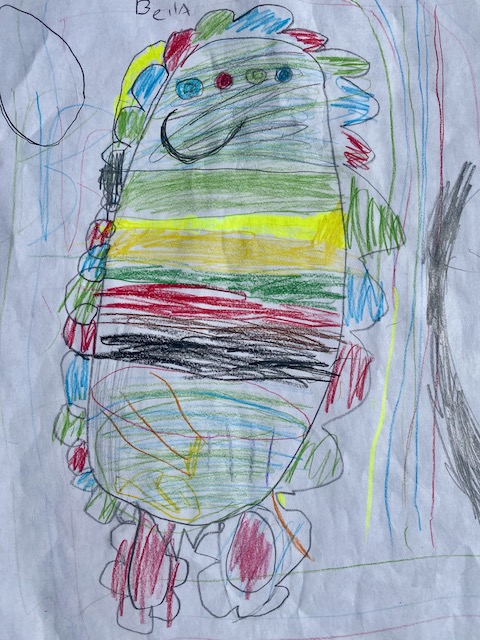
The 5th graders used felt to recreate the 1st graders’ drawing using felt. They were then sewn together with yarn and stuffed with filling.
Preparing the Plushy
The SAGE students created larger versions of the 1st graders’ drawn monsters through using felt pieces for the base and the features of the drawing, adding a back, sewing it today with yarn, and stuffing it
Interviewing the 1st Graders
The interview questions were developed by the SAGE students first by brainstorming ideas on the Promethean board, and second sharing them on a Google Doc so they each had a copy:
Interviews
The SAGE 5th graders interviewed the 1st graders about their Monsters using Vocaroo. It produces a MP3 file which is compatible with Scratch. This file is downloaded.
Preparing the Files in Scratch
The SAGE students then uploads their MP3 files into Scratch where it is edited into clips of sounds. This link gives some details how to do so https://helpkidscreate.com/adding-audio-to-scratch/.


See more of their code:
- Elizabeth – https://scratch.mit.edu/projects/793092586
- Tao – https://scratch.mit.edu/projects/811334666/
- Emily – https://scratch.mit.edu/projects/827406003
- Valerie – https://scratch.mit.edu/projects/796614386
- Emily (Spanish Version) – https://scratch.mit.edu/projects/830970807
After the 5th graders made the plushies, they prepared them to be connected to the Makey Makey by taping in conductive tape and sewing in conductive thread as described in https://makeymakey.com/blogs/how-to-instructions/maker-class-lesson-two-hack-a-toy


The Reveal to the 1st Graders
When all of the projects were complete, they were set up in our classroom and the 1st graders were brought in for the reveal.
Presenting Their Projects at Our Innovation Fair
Several SAGE students presented their Monster Projects at our district’s innovation fair.
Extra – Animated Drawings and Blabberize
As an extra project and to enable younger students to get more involved with the technology, the older students can help them animated their drawings using https://sketch.metademolab.com/:
which can then be uploaded to Canva to create a party of multiple monsters:
To learn how to do this, see the @theMerrillsEDU tutorial at https://youtu.be/JTukQCTj2fo?si=kdsM0vTyekRLFaRY
or Blabberize their monsters.
- http://blabberize.com/view/id/2165233
- http://blabberize.com/view/id/2165238?secret=f97ef182
- http://blabberize.com/view/id/2165250
- http://blabberize.com/view/id/2165249
- http://blabberize.com/view/id/2159218
Standards Addressed
CCSS – English Language Arts
- Interpret information presented in diverse media and formats (e.g., visually, quantitatively, orally) and explain how it contributes to a topic, text, or issue under study.
National Core Arts Standards
- Students will generate and conceptualize artistic ideas and work.
CSTA Standards
- Decompose (break down) problems into smaller, manageable subproblems to facilitate the program development process.
- Modify, remix, or incorporate portions of an existing program into one’s own work, to develop something new or add more advanced features.
ISTE Standards for Students
- Students create original works or responsibly repurpose or remix digital resources into new creations.
- Students publish or present content that customizes the message and medium for their intended audiences.
NAGC (National Association for Gifted Children) Standards
- Standard 1: Gifted individuals demonstrate skills, abilities, and potential commensurate with high performance.
- The project demonstrates the students’ advanced skills in creativity, problem-solving, and technical proficiency in programming and electronics.
- Standard 2: Gifted individuals demonstrate task commitment and perseverance to high-level work.
- The project showcases the students’ commitment and perseverance as they went through multiple stages, from creating stuffed animals to conducting interviews, programming, and connecting the Makey Makeys.
- Standard 3: Gifted individuals demonstrate creativity and risk-taking.
- The project involves the students’ creative thinking and risk-taking as they transformed the monster drawings into physical stuffed animals and integrated technology to make the interviews interactive.
- Standard 4: Gifted individuals demonstrate the ability to work both independently and within groups.
- The project required the students to collaborate within their group to complete different aspects, such as designing the stuffed animals, conducting interviews, programming in Scratch, and connecting the Makey Makeys.
- Standard 5: Gifted individuals demonstrate effective communication skills.
- The students exercised their communication skills during the interviews with the 1st graders and also used technology to convey their messages through the Scratch programming language and the Makey Makey connections.
- Standard 8: Gifted individuals demonstrate sensitivity to their own and others’ well-being.
- The project fostered empathy and awareness as the older students interacted with the 1st graders and translated their drawings into tangible stuffed animals, providing a sense of validation and pride for the younger children
